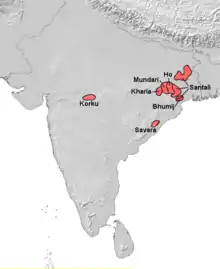Munda peoples
The Munda peoples of eastern and central parts of South Asia are any of several tribal groups of people who natively speak Munda languages, formerly also known as Kolarian.
 Distribution of Munda language speakers in India | |
| Regions with significant populations | |
|---|---|
| India, Bangladesh | |
| Languages | |
| Munda languages |
History
According to linguist Paul Sidwell, Munda languages arrived on the coast of Odisha from Southeast Asia about 4000-3500 years ago.[1] The Munda people spread from Southeast Asia and mixed extensively with local Indian populations.[2] Robert Parkin notes that the term "Munda" did not belong to the Austroasiatic lexis and is of Sanskrit origin.[3]
Austroasiatic DNA
Mitsuru Sakitani suggests that Haplogroup O1b1, which is common in Austroasiatic people and some other ethnic groups in southern China, and haplogroup O1b2, which is common in today Japanese, Koreans and some Manchu, are the carriers of Yangtze civilization (Baiyue).[4] Another study suggests that the haplogroup O1b1 is the major Austroasiatic paternal lineage and O1b2 the “para-Austroasiatic” lineage of the Yayoi people.[5]
Migration into India
According to Chaubey et al., "Austro-Asiatic speakers in India today are derived from dispersal from Southeast Asia, followed by extensive sex-specific admixture with local Indian populations."[6] According to Riccio et al., the Munda people are likely descended from Austroasiatic migrants from Southeast Asia.[7][8]
According to Zhang et al., Austroasiatic migrations from Southeast Asia into India took place after the last Glacial maximum, circa 10,000 years ago.[9] Arunkumar et al. suggest Austroasiatic migrations from Southeast Asia occurred into Northeast India 5.2 ± 0.6 kya and into East India 4.3 ± 0.2 kya.[10]
Ethnic groups
- Munda people
- Ho people
- Santhal people
- Birhor people
- Bhumij people
- Korwa people
- Kodaku people
- Korku people
- Kharia people
- Juang people
- Sabar people
- Sora people
- Gorum (Parenga) people
- Gadaba people (Only some Gadabas speak the Bonda-related Gutob language. Some others speak a Dravidian language.)
- Bonda people
- Didayi (Dire, Gta’) people
Possible kins of the Munda peoples
Some ethnic groups do not natively speak any of the Munda tongues, but nevertheless have been linked by some to the Munda lede grounded upon anthropological or genetic token:
References
- Sidwell, Paul. 2018. Austroasiatic Studies: state of the art in 2018. Presentation at the Graduate Institute of Linguistics, National Tsing Hua University, Taiwan, 22 May 2018.
- Schliesinger, Joachim (2016). Origin of the Tai People 3: Genetic and Archaeological Approaches. Booksmango. p. 71. ISBN 9781633239623. Retrieved 3 October 2019.
- Parkin, Robert (1993). "Second Reply to Pfeffer" (PDF). University of Oxford. p. 161. Retrieved December 18, 2020.
The term 'Munda' is of Sanskritic origin and therefore not original in any sense to Austroasiatic speakers, although it has come to be used by one tribe as an alternative to their own term 'Horo' (Le. Roy's group; cf. Pfeffer above, p. 154; also Parkin 1990: 17, 23).
- 崎谷満『DNA・考古・言語の学際研究が示す新・日本列島史』(勉誠出版 2009年)
- Robbeets, Martine; Savelyev, Alexander (21 December 2017). Language Dispersal Beyond Farming. John Benjamins Publishing Company. ISBN 9789027264640.
- Chaubey et al. 2010, p. 1013.
- Riccio, M. E.; et al. (2011). "The Austroasiatic Munda population from India and Its enigmatic origin: a HLA diversity study". Human Biology. 83 (3): 405–435. doi:10.3378/027.083.0306. PMID 21740156. S2CID 39428816.
- The Language Gulper, Austroasiatic Languages
- Zhang 2015.
- Arunkumar, G.; et al. (2015). "A late Neolithic expansion of Y chromosomal haplogroup O2a1-M95 from east to west". Journal of Systematics and Evolution. 53 (6): 546–560. doi:10.1111/jse.12147. S2CID 83103649.
External links
- http://projekt.ht.lu.se/rwaai RWAAI (Repository and Workspace for Austroasiatic Intangible Heritage)
- http://hdl.handle.net/10050/00-0000-0000-0003-66EE-3@view Munda languages in RWAAI Digital Archive
